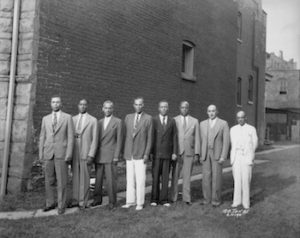
(L to R)L. O. Mason, Bennie Smith, Ashley Totten,
T. T. Patterson, A. Philip Randolph,
Milton P. Webster, C. L. Dellums, E. J. Bradley 1930
*The industrial town of Pullman, Illinois, began on this date in 1880. Pullman was an urban town in Chicago where African American Pullman Porters lived.
This town was the brainchild of George M. Pullman, President of Pullman's Palace Car Company. He developed a model community, a total environment superior to that available to the working class after the Reconstruction era. By doing so, he hoped to avoid strikes, attract the most skilled workers, and achieve greater productivity due to the improved health, environment, and morale of his employees and the community of Pullman. As the Industrial Revolution began and the Great Migration took hold, Pullman recognized the necessity of having access to the big city markets and railroad connections throughout the entire country.
The 4,000-acre tract selected for the site lay along the western shore of Lake Calumet, 13 miles directly south of Chicago. It was essentially open prairie and marshland linking Chicago to the southern states by the Illinois Central Railroad and to the world by Lake Calumet’s connection to Lake Michigan and the St. Lawrence River. He hired Solon S. Beman, landscape architect Nathan F. Barrett, and civil engineer Benzette Williams to design the town. Pullman employees built the town. Structures were made of brick from clay found in Lake Calumet. Pullman shops produced parts used to create the town.
This project was one of the first applications of industrial technology and mass production in the construction of a large-scale housing development. The town of over 1,000 homes and public buildings was completed by 1884. Each dwelling had access to gas and water, complete sanitary facilities, and ample sunlight and fresh air. Front and back yards provided personal green space, while parks and open lands provided larger, shared ones. Maintenance of the residences was included in the rental prices, as was daily garbage pickup.
Pullman was voted the world's most perfect town at the Prague International Hygienic and Pharmaceutical Exposition of 1896, yet the town’s misfortune came during the depression that followed the Panic of 1893. When demand for Pullman cars slackened, the Pullman company laid off hundreds of workers and switched many more to pay-per-piece work. This work, although paying more per hour, resulted in a reduction of total worker income. Despite these cutbacks, the Company did not reduce rents for those living in Pullman.
The Pullman Strike began in 1894 and lasted for two months, eventually leading to intervention by the US government and military. The Strike Commission, set up in 1894, ruled that the aesthetic features admired by visitors had little monetary value for employees. Today, Pullman is a vibrant, historic community dedicated to preserving its heritage.